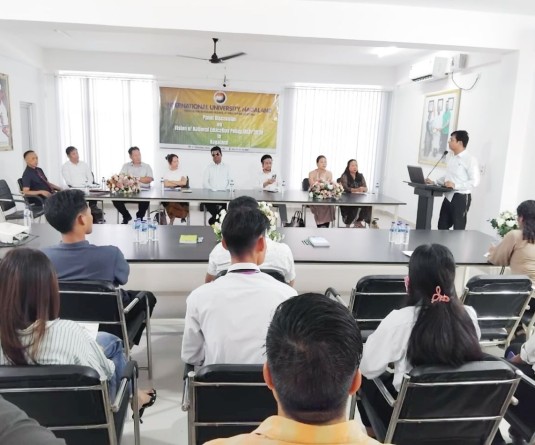Dr Ashiho A Mao, Director, Botanical Survey of India addressing the seminar on August 8. (Morung Photo)
.jpg)
Morung Express news
Kohima | August 8
In Nagaland, around 11 species of Rhododendrons are found ranging from different varieties and colours, where majority of them are of common species but mostly endemic to the region, Director, Botanical Survey of India Dr Ashiho A Mao opined during a seminar and plantation on “Rhododendron and sustainable tourism” organized by Botanical Survey of India, Kolkata in collaboration with Rhododendron Park, Jakhama today.
Mao who has worked on Rhododendron for over 20 years and co-authored a book, “Rhododendrons of Northeast” observed that although it is originally found in our region, the prospects are yet to be explored and so also not valued.
Commenting that the plantation and presence of Rhododendron was much higher in western countries, he lamented that the people in our region seldom take care of the varieties of Rhododendron endemic to the region.
“In Western Countries, they have very few species but they have collected from all the Himalayan region as is maximum in China and eastern Himalayan. Today, they have thousand species and it is a multimillion dollar business,” he remarked.
Observing that the Northeast region falls under the eastern Himalayas, where the highest number of Rhododendron species are found, the Director said varieties are found in Arunachal Pradesh, Nagaland, Manipur, Sikkim and Meghalaya where around a 100 of them is found in Arunachal Pradesh which lies close to China.
Dr Ashiho said the conception of people in an area needs to change and evolve where we consider anything coming from outside to be better and superior.
“We are losing our biodiversity because of introducing too much foreign species which is threatening our own native plants,” he said.
Stating that many varieties are being dominated by those outside place, he warned that invasive foreign species are on the rise which poses potential danger of spreading uncontrollably. “One has to be very wise and careful while introducing such species/plants to our area,” Dr. Ashiho advised.
He advised that one can adopt and explore practices to expand the species such as plant hunting practices, nursery, hybridization which is turn have huge potential for its ornamental and medicinal purpose. “If we are ready to bring lots of ornamental plants at high price, we must be willing to sell our plants too.”
On eco tourism, he pointed out that it required less resources but more of creativity and maintenance.
Senior SP, Kohima Kevithüto Sophie, IPS dwelled on sustainable survival where eco tourism can be a part of it. He called for collective effort towards preserving and conserving nature. Sophie said activities such as stone quarrying, hunting, fishing etc taking place in our region could cause permanent damage to the ecosystem.
The welcome address was delivered by Er Tepul Tase and programme was chaired by Dr. Keluhol Tase. The Eco Club of Loyola Higher Secondary School, Jakhama presented the theme song and Tati (folktune) was also presented by Ketonu Richa.





